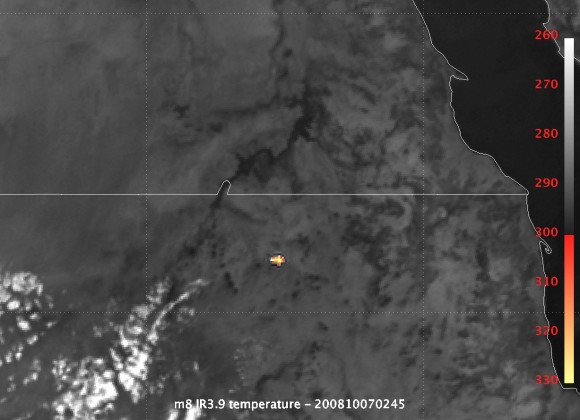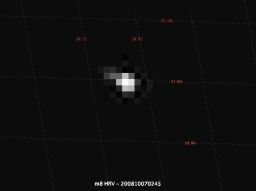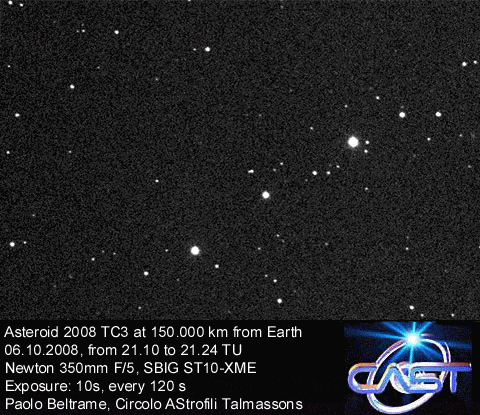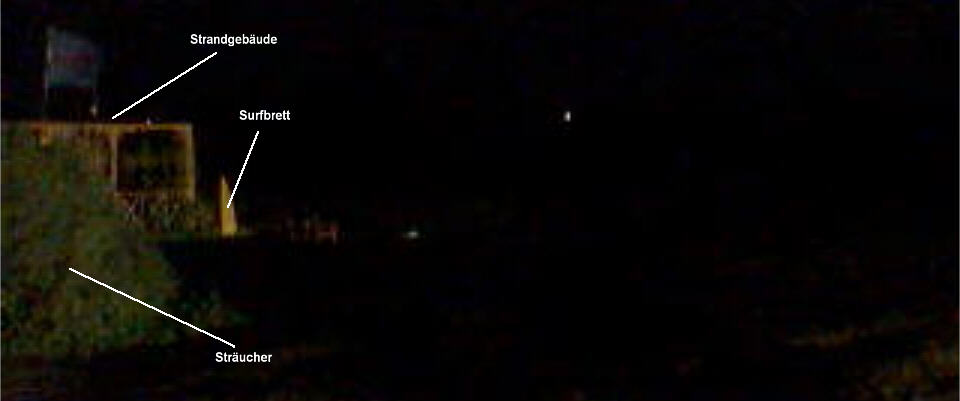[/caption]
One of the big news items last week was the prediction that an asteroid was on a collision course with Earth. Although it was a small space rock – estimates ranged from 1-5 meters (3-15 feet), scientists were excited because this was the first time an asteroid was discovered with an imminent known impact. Granted, we’d all probably feel a little safer if we knew about this asteroid, named 2008 TC3, days or months ahead of time instead of only 19 hours, but it’s a step in the right direction. Astronomers even predicted correctly the asteroid would come through the atmosphere over Africa. So with this prediction, many were hoping someone with a camera would be watching the skies of Sudan. But the flight path of the object was over a remote area and so far the only ground-based image that has surfaced is the one shown here, taken by a webcam from a beach in Egypt. (The words on the image indicate the objects on the beach — which were illuminated by the fairly distant explosion low on the horizon. try to find the tiny bright spot in the center of the image — that’s the asteroid.) But we do have satellites constantly monitoring Earth’s atmosphere and a few of them captured images and data about 2008 TC3. However, it’s not known if any parts of the meteoroid hit the ground.
The explosion was recorded directly by the cameras of a European weather satellite called METEOSAT-8. This was taken in infrared, and the temperature scale on the right is in Kelvin.

Data from this satellite helped determine the asteroid entered Earth’s atmosphere at a velocity of 12.8 kilometers per second. “As it entered the Earth’s atmosphere, it compressed the air in front of it. The compression heated the air, which in turn heated the object to create a spectacular fireball, releasing huge amounts of energy as it disintegrated and exploded in the atmosphere, dozens of kilometers above ground,” the Eumetsat website explains. Meteostat also took a visible image:

Also, according JPL’s Near Earth Object Program, an undisclosed U.S. system has monitored the airburst and yielded a precise time (02:45:45 UTC) and explosive energy equivalent (0.9 to 1.0 kT of TNT). The NEO office also said, “Tthe follow-up astrometric observations from professional and sophisticated amateur astronomers alike were rather extraordinary, with 570 observations from 26 observatories being reported between the time of discovery by the Catalina Sky Survey to just before the object entered Earth’s shadow (57 minutes prior to impact).” These observations revealed a tumbling, rotating object. The CAST astronomical observatory created a “movie” of their observations of the asteroid before it entered into Earth’s shadow.

Here’s links to a few other ground based observatories and their pre-impact sightings: from Eric Allen of Observatoire du Cegep de Trois-Rivieres, Champlain, Quabec; from Ernesto Guido et al. of Remanzacco Observatory, Italy; from S.Korotkiy and T.Kryachko of Kazan State University Astrotel observatory, Russia
Also, SpaceWeather.com reported the crew of an airplane saw a flash in the sky which may have been from this object. But beyond that, sadly, there’s not many images available related to this extraordinary event. If any surface, we’ll be sure to post them.
Sources: SpaceWeather.com, Cosmos4U, Planetary Society Blog, JPL NEO Program


I must correct the first paragraph!
The webcam is actually pointing in the wrong direction, across the red sea. The little dot in the middle is not the asteroid.
The effect is that the asteroid fireball lit up the scenery strongly, illuminating the buildings for a few seconds. The beach itself is hardly illuminated, indicating a light source close to the horizon. Furthermore, the webpage states that as colors are readily visible in the images, the brightness must have been equal to that of the full moon or more.
One does wonder that now one was outside looking south…
Thank you Don for that correction. One source I read indicated the asteroid was the bright spot, but other sources do in fact indicate the objects on the beach were illuminated by the flash. The text has been corrected.
Nancy
There seems to be some confusion between an asteroid and meteoroid. Let’s repeat:
* meteoroid: a rock in space smaller than asteroid
* meteor: the bright event caused by a meteoroid falling through atmosphere with a cosmic speed (bolide = a very bright meteor)
* meteorite: a rock survived from an atmospheric entry
🙂
I made the screenshots from the El Gouna webcam. And I can say that Don Alexander is right. The tiny spot in middle of the image could be a light somewhere from the coast on the other side of the Red Sea. It is not even a star or a ship, because the light was fixed for hours.
I made an update of my webpage and you can also see an animation of some screenshots here:
http://home.pages.at/thie/asteroid_2008_tc3/animation.html
Please send anymore images of TC3 to my email address.
Thank You
C. Webster Rose
For interest the link give daylight shots from the same webcam. Taking a look at the shadows cast I would say that the view is in a northeasterly direction. Measuring from Google Earth, this beach site is about 740 miles north-north-east from the explosion site.
http://www.kitepower-elgouna.com/webcam/webcam-archive/index.php
Zumthie-
Thanks for adding the link for the animation! Very interesting.
Nancy
Can anyone make a screenshot of the liveview of the webcam in El Gouna tonight? I cannot connect to the webcam. Now we have full moon and it could be interesting to see what the illumination difference is.
http://www.kitepower-elgouna.com/de/el_gouna/webcam/
Thank you
It will be interesting to see if these features will remain once the planet’s axis changes in relation to the sun.
If the seasons change, then will the storms “reverse” poles, so to speak?
Exciting times!
Woops, wrong topic – too many windows open!